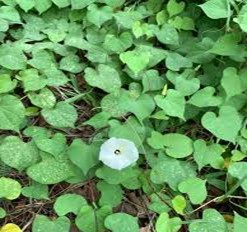Abstract
Ipomoea obscura (L.), known as “Laksmana” in Ayurvedic medicine, is a climbing herb from the Convolvulaceae family, widely distributed in India. This review explores its traditional uses, phytochemistry, and mainly pharmacological activities. Traditionally, Ipomoea obscura is used for treating diarrhoea, ulcers, and inflammatory conditions. Phytochemical analysis reveals a wealth of compounds including flavonoids, phenolics, and alkaloids, which underpin its therapeutic efficacy. Scientific studies highlight its anti-inflammatory, antioxidant, nephroprotective, anti-viral, anti-arthritic activity, antidiarrheal Activities, hepatoprotective activity, anti-angiogenic activity, immunomodulatory activity and anti-fungal properties. Additionally, the plant's ability to synthesize silver nanoparticles demonstrates its potential in green chemistry and antifungal applications. Its broad spectrum of bioactivities and rich phytochemical profile make Ipomoea obscura a promising candidate for developing new therapeutic agents. Future research should aim to further elucidate its mechanisms, optimize clinical applications, and explore its role in integrative medicine.
Keywords
Ipomoea obscura (L.), Pharmacological activity, Review
Introduction
Ipomoea obscura (L.), often referred to in Ayurvedic texts as “Laksmana,” is a plant belonging to the Convolvulaceae family. This petite climber features small, heart-shaped leaves with pointed tips. Its corolla is composed of five completely fused petals. Thriving in disturbed areas, it can grow on fences or serve as a low ground cover. This slender, twinning perennial herb is found in grasslands, hedgerows, and wastelands throughout India, up to elevations of 3000 feet. In addition to its climbing habit and attractive flowers, it holds ornamental value (1).
Traditional uses
Ayurveda has recognized the medicinal properties of this plant, utilizing it to treat diarrhoea, open sores, and pustules. A paste made from its leaves is employed to heal ulcers, haemorrhoids, and swellings. Additionally, its fruits and seeds are used as purifying agents, aiding in alleviating breathing difficulties, relieving pain, and enhancing vision (2). Extracts from Ipomoea obscura have demonstrated anti-inflammatory, nephroprotective, anti-angiogenic, and immunomodulatory effects (3). Methanol extracts of Ipomoea obscura have been shown to possess significant cytotoxic properties and moderate antibacterial activity (4). Extracts from the entire Ipomoea obscura plant exhibit strong antioxidant activity against a range of free radicals (5). To treat colds, asthma, and dry cough, the fresh plant extract is mixed with gingely oil. The extract alleviates bodily pain by dilating blood vessels. Numerous Siddha medicines incorporate these plant extracts (6).
PHYTOCHEMISTRY
Preliminary phytochemical analysis of Ipomoea obscura leaves revealed the presence of flavonoids, phenolics, tannins, steroids, alkaloids, saponins, anthraquinones, and terpenoids (methanol extract contained the highest concentrations). The inorganic elements analysis indicated the presence of calcium, magnesium, sodium, potassium, sulfate, phosphate, chloride, and nitrate, but iron was absent (7). Leaves of Ipomoea obscura are rich in vitamins A, B1, B2, B3, and C. This makes them an excellent dietary choice for rural populations who cannot afford costly exotic vegetables, which may lack many of the nutrients found in this local, wild, and often overlooked species (8). The methanolic seed extract of Ipomoea obscura yielded five indole alkaloids (9).

PHARMACOLOGICAL ACTIVITIES OF IPOMOEA OBSCURA
Anti-arthritic activity
The bioactive components of Ipomoea obscura leaves have been studied, revealing various chemical compounds responsible for their therapeutic properties. The phytochemical analysis and in vitro anti-arthritic activity of Ipomoea obscura leaf extracts have been examined. Qualitative analysis of both ethanolic and aqueous extracts of Ipomoea obscura leaves indicated the presence of tannins, saponins, flavonoids, terpenoids, polyphenols, glycosides, and coumarins. However, steroids, triterpenoids, and anthraquinones were only absent in the aqueous extract. Notably, a significant amount of flavonoids (10.00±0.24 mg/gm) and total phenols (189.00±1.12 mg/gm) were detected in the leaves of Ipomoea obscura. The extracts demonstrated potential in vitro anti-arthritic activity, confirmed through protein denaturation assays (10).
Anti-inflammatory and Antidiarrheal Activities
The anti-inflammatory and antidiarrheal properties of Ipomoea obscura were assessed using several tests: carrageenan-induced paw edema and cotton pellet granuloma in rats, as well as castor oil-induced diarrhoea and the charcoal meal test in mice. When administered orally to mice at a single dose of 2000 mg/kg, the ethanol extract showed no behavioral changes or mortality, indicating an LD50 greater than 2000 mg/kg. In rats, the ethanol extract at doses of 250 and 500 mg/kg significantly (p<0>
Anti-oxidant activity
Cyclophosphamide (CP) is commonly utilized, either by itself or combined with other chemotherapeutic agents, to treat various neoplastic conditions. However, its urotoxicity can lead to severe side effects such as haemorrhagic cystitis, which may further result in nephrotoxicity. This study examined the protective effects of Ipomoea obscura against CP-induced urotoxicity and nephrotoxicity in animal models. Swiss albino mice were administered an acute dose of CP (1.5 mmol/kg body weight intraperitoneally) with or without the alcoholic extract of Ipomoea obscura (10 mg/kg body weight intraperitoneally) for five days. The extract effectively reversed CP-induced toxicities, as indicated by reductions in BUN and serum creatinine levels, alongside an increase in body weight. Moreover, there was a notable enhancement in the kidney's antioxidant defence system, including increased levels of GSH, SOD, CAT, and GPx in the extract-treated animals. Histopathological evaluations of the urinary bladder and kidneys revealed that the tissue damage caused by CP was significantly mitigated in the animals treated with Ipomoea obscura. Additionally, the decreased levels of cytokines IFN-? and IL-2 following CP treatment were elevated in the treated animals, while the heightened level of the proinflammatory cytokine TNF-? was substantially reduced by the extract. This study clearly demonstrates that Ipomoea obscura can alleviate CP-induced bladder and kidney toxicities by enhancing antioxidant defences and modulating proinflammatory cytokine levels (12).
Nephroprotective activity
This study was conducted to assess the nephroprotective effects of the crude powder derived from the leaves of Ipomoea obscura Linn in both normal and gentamicin-induced nephrotoxic rats. Nephrotoxicity was induced in male albino rats, weighing between 100-120 grams, using gentamicin over a period of 30 days. The study also examined the impact of the plant's crude powder treatment on the haematological and renal histological profiles of these nephrotoxic rats. Ipomoea obscura, utilized in the Siddha system of medicine, is known for its therapeutic properties and biological activity against various diseases (13).
Anti-viral activity
Angiotensin converting enzyme 2 (ACE2) and main protease (MPro) are key target proteins involved in the attachment and replication of the severe acute respiratory syndrome coronavirus (SARS-CoV) genome within host cells. This study identified 11 potent bioactive compounds from the ethanolic leaf extract of Ipomoea obscura (L.) using GC-MS analysis. These bioactive compounds were subjected to molecular docking studies against ACE2 and MPro target proteins to evaluate their antiviral effects against SARS-CoV. The results indicated that among the 11 compounds from Ipomoea obscura (L.), urso-deoxycholic acid, demeclocycline, tetracycline, chlorotetracycline, and ethyl iso-allocholate demonstrated significant viral inhibitory activity. Thus, these findings suggest that the chemical constituents of Ipomoea obscura (L.) may inhibit coronavirus replication in host cells (14).
Hepatoprotective activity
This study aimed to investigate the phytochemical, histochemical, fluorescence, and GC-MS properties of Ipomoea obscura leaves, as well as their hepatoprotective activity. The findings suggest that the leaves of Ipomoea obscura are rich in phytochemicals, exhibit significant histochemical and fluorescence characteristics, and show promising results in GC-MS analysis. Overall, Ipomoea obscura leaves are a valuable source of phytochemicals with hepatoprotective properties, which could be beneficial in treating oxidative stress-related diseases such as diabetes, cancer, and arthritis (15).
Anti-fungal activity
The synthesis of silver nanoparticles (AgNPs) using the leaf extract of Ipomoea obscura via a green chemistry approach offers a sustainable and environmentally friendly method. This study explores the synthesis, characterization, and antifungal properties of these nanoparticles. The synthesis of AgNPs was indicated by a colour change in the reaction mixture from pale yellow to dark brown. UV-visible spectroscopic analysis revealed an absorption band at 430 nm, confirming the formation of silver nanoparticles. The synthesized nanoparticles were characterized using various techniques. The XRD spectrum displayed three distinct diffraction peaks at 2? values of 37.89°, 43.96°, and 64.32°, corresponding to the lattice planes (111), (200), and (220) respectively, indicating a face-centered cubic structure. DLS analysis determined the particle size to be approximately 46 nm. FTIR was employed to identify possible functional groups involved in the synthesis process. SEM images revealed the nanoparticles' cubic shape. EDAX confirmed the presence of elemental silver in the nanoparticles. The synthesized AgNPs demonstrated significant fungicidal activity against various pathogens including Didymella bryoniae, Fusarium oxysporum, Fusarium moniliforme, and Aspergillus flavus. This study highlights the effective green synthesis of silver nanoparticles using Ipomoea obscura leaf extract. The nanoparticles were thoroughly characterized, confirming their size, shape, and elemental composition. Additionally, their potent antifungal properties suggest potential applications in agricultural and medical fields for combating fungal infections (16).
Antibacterial activity
Leaf, stem, and seed samples of Ipomoea obscura were tested against nine human pathogenic bacterial strains. These included four Gram-positive bacteria—Staphylococcus aureus, Bacillus subtilis, Bacillus stearothermophilus, and Rhodococci sp.—and five Gram-negative bacteria—Escherichia coli, Escherichia coli (Positive strain), Proteus vulgaris, Pseudomonas sp., and Salmonella sp. (MTCC). The results showed that all extracts from the leaf, stem, and seed inhibited bacterial growth, confirming their antibacterial properties. Among the samples, the stem extract demonstrated the highest antibacterial activity. Notably, all three extracts inhibited the growth of Salmonella sp. (MTCC), with zones of inhibition measuring 16 mm for the leaf, 18 mm for the stem, and 14 mm for the seed. Given that Salmonella is a known cause of liver disorders such as dysentery and diarrhoea, it can be concluded that Ipomoea obscura exhibited hepatoprotective activity (17).
Anti-angiogenic activity
Ipomoea obscura and its compound IPO-A have been found to notably inhibit various endothelial cell functions in vitro, including proliferation, migration, invasion, and tube formation. Additionally, VEGF-induced sprouting of endothelial cells from rat aorta was suppressed ex vivo. Treatment with the extract or IPO-A led to a significant reduction in the production of matrix metalloproteinases (MMPs) and the expression levels of VEGF, cyclooxygenase-2, and nitric oxide synthase in B16F10 cells. In vivo, intraperitoneal administration of the extract significantly impeded neo-vessel formation induced by the B16F10 melanoma cell line in C57BL/6 mice. Furthermore, serum cytokine analysis revealed that the extract notably decreased elevated levels of pro-inflammatory cytokines, including IL-1?, IL-6, TNF-?, and GM-CSF, as well as the key angiogenic factor VEGF. The serum NO level was also significantly reduced by the extract administration, while levels of antiangiogenic factors such as TIMP-1 and IL-2 were elevated in treated animals (18).
Immunomodulatory activity
Synthetic chemotherapeutic agents commonly available today are often immunosuppressive, cytotoxic, and associated with a variety of adverse effects. To mitigate these side effects and restore health, botanical-based immunomodulators are frequently used as supportive or adjuvant therapies. The methanolic extract of Ipomoea obscura, a medicinal plant of traditional importance, has demonstrated immunomodulatory properties in BALB/c mice. Administering five intraperitoneal doses of the extract (10 mg/kg body weight) led to a significant increase in total WBC count (13,912 cells/mm?3;) on the 12th day, enhanced bone marrow cellularity (28.9 × 10? cells/femur), and a higher number of ?-esterase positive cells (1,246 cells/4,000 cells). When administered with the antigen, sheep red blood cells (SRBC), the extract boosted the circulating antibody titer and increased the number of plaque-forming cells (PFC) in the spleen, with the maximum PFC count (267.6 PFC/10? spleen cells) observed on the 6th day. Additionally, the Ipomoea obscura extract significantly reduced elevated levels of proinflammatory cytokines and nitric oxide production in lipopolysaccharide-stimulated macrophages. These findings indicate the immunomodulatory potential of the alcoholic extract of Ipomoea obscura (19).
CONCLUSION:
Ipomoea obscura (L.) stands out as a multifaceted plant with substantial therapeutic potential, as evidenced by its diverse pharmacological activities and rich phytochemical profile. Traditionally valued in Ayurvedic and Siddha medicine, this plant demonstrates efficacy in treating a variety of conditions, including diarrhoea, inflammation, and pain, alongside a host of other ailments. Its medicinal applications are supported by scientific research, which highlights its anti-inflammatory, antioxidant, nephroprotective, and immunomodulatory effects. The phytochemical analysis of Ipomoea obscura reveals the presence of valuable compounds such as flavonoids, phenolics, and alkaloids, which contribute to its broad-spectrum pharmacological activities. The plant's ability to synthesize silver nanoparticles further underscores its utility in green chemistry and antifungal applications. Additionally, studies confirmed its potential in combating bacterial and viral infections, and its hepatoprotective properties suggested it could be beneficial for treating oxidative stress-related diseases. Overall, Ipomoea obscura represents a promising natural resource with significant therapeutic potential. Future research should focus on further elucidating its mechanisms of action, optimizing its applications in clinical settings, and exploring its role in integrative and complementary medicine. Its rich phytochemical content and demonstrated bioactivities make it a valuable candidate for developing novel therapeutic agents and health-promoting strategies.
REFERENCES
- Eckart E. Solanaceae and Convolvulaceae – secondary metabolite. 2008;1:637
- Christophe W. Ethnopharmacology of medicinal plants: Asia and the Practice. Vol. 1. Humana press; 2002. p. 6928.
- Kiritikar KR, Basu BD. Indian medicinal plants. Vol. III. Dehradun, India: International Book Distributors; 1999. p. 1722-3.
- Srinivasan R, Rajan S, Ashok D, Kumarappan C. Cytotoxic and antimicrobial activity of Ipomoea obscura. Aust J Basic Appl Sci. 2014;8(1):529-32.
- Srinivasan R, Chandrasekar MN, Nanjan MJ, Suresh B. Free radical scavenging activity of Ipomoea obscura (L.) Ker-Gawl. J Nat Rem. 2007;7(2):184-8.
- Sripathi SK, Sankari U. Ethnobotanical documentation of a few medicinal plants in the Agasthiayamalai Region of Tirunelveli District, India. Ethnobotanical Leafl. 2010;14:173-81.
- Chitra C, Dhanaraj TS. Phytochemical and HPLC analysis of Ipomea obscura leaves. Asian Journal of Innovative Research. 2016;1(4):39-44.
- Ewa O, Amah AK, Ejiofor DC, Opara JK, Orabuike JC. Evaluation of mineral and vitamin compositions of leaf of obscure morning glory (Ipomoea obscura).
- Jenett-Siems K, Weigl R, Kaloga M, Schulz J, Eich E. Ipobscurines C and D: macrolactam-type indole alkaloids from the seeds of Ipomoea obscura. Phytochemistry. 2003 Apr 1;62(8):1257-63.
- Elakkiya M, Santhi G. A study on phytochemical analysis and in vitro anti-arthritics activity of Ipomoea obscura LEAVES. Asian Journal of Innovative Research. 2022;6(1):01-4.
- Seshadri Sekhar D, Kumar A, Dhanasekaran S, Suresh B, Chickballapur KI. Anti-inflammatory and Antidiarrhoeal Activities of Ethanol Extract of Ipomea obscura.
- Hamsa TP, Kuttan G. Protective role of Ipomoea obscura (L.) on cyclophosphamide-induced uro-and nephrotoxicities by modulating antioxidant status and pro-inflammatory cytokine levels. Inflammopharmacology. 2011 Jun;19:155-67.
- Elango V, Vallabi DE. Effect of Ipomea obscura Linn in Nephrotoxic Induced in Experimental Rats. World Journal of Pharmaceutical Research. 2015 May 26;4:1641-51.
- Poochi SP, Easwaran M, Balasubramanian B, Anbuselvam M, Meyyazhagan A, Park S, Bhotla HK, Anbuselvam J, Arumugam VA, Keshavarao S, Kanniyappan GV. Employing bioactive compounds derived from Ipomoea obscura (L.) to evaluate potential inhibitor for SARS?CoV?2 main protease and ACE2 protein. Food frontiers. 2020 Jun;1(2):168-79.
- Meena B, Santhi G. Phytochemical screening and in vitro hepatoprotective activity of Ipomoea obscura. World Journal of Pharmaceutical Research. 2018;7(3):1623-36.
- Garmpalli RH. Phytogenic synthesis of silver nanoparticles using Ipomoea obscura(L) leaves extract and its fungicidal activity against phytopathogens. Journal of Advanced Scientific Research. 2021 Jun 30;12(02 Suppl 1):186-93.
- Mungole AJ, Awati R, Chaturvedi A, Zanwar P. Preliminary Phytochemical screening of Ipomoea obscura(L)-A hepatoprotective medicinal plant. International Journal of PharmTech Research. 2010 Oct;2(4):2307-12.
- Hamsa TP, Kuttan G. Anti-angiogenic activity of Ipomoea obscura extract and Ipobscurine-A. Immunopharmacol Immunotoxicol. 2011 Sep;33(3):488-97. doi: 10.3109/08923973.2010.531277. Epub 2010 Nov 9. PMID: 21058930.
- Hamsa TP, Kuttan G. Ipomoea obscura (L.) enhances the functions of immunological effector cells, inhibits proinflammatory cytokines and nitric oxide production by LPS induced macrophages. Immunopharmacol Immunotoxicol. 2009 Jun;31(2):222-9. doi: 10.1080/08923970802382227. PMID: 18798043.


 Razana Binth Yoosuf P*
Razana Binth Yoosuf P*
 Neethu Varghese
Neethu Varghese
 Sethu R
Sethu R
 Rahila
Rahila
 Shafnaz Abdul Rahman
Shafnaz Abdul Rahman
 Rubayyath K
Rubayyath K
 Digi Davis C
Digi Davis C
 Neeshma K
Neeshma K
 Ramsiya K
Ramsiya K

 10.5281/zenodo.13329942
10.5281/zenodo.13329942